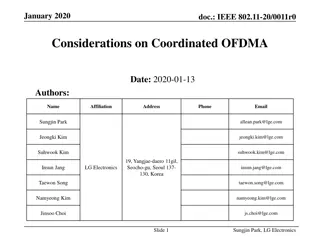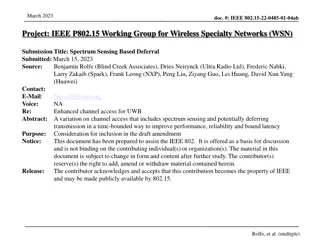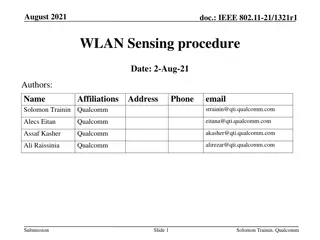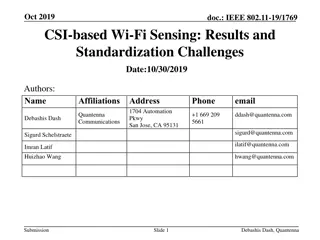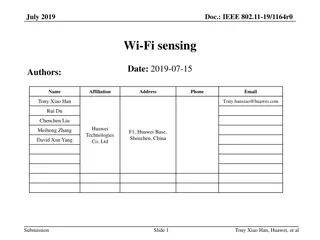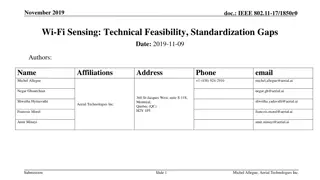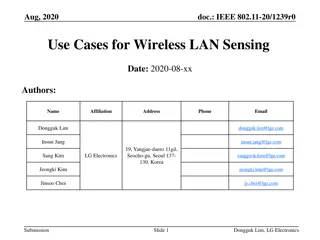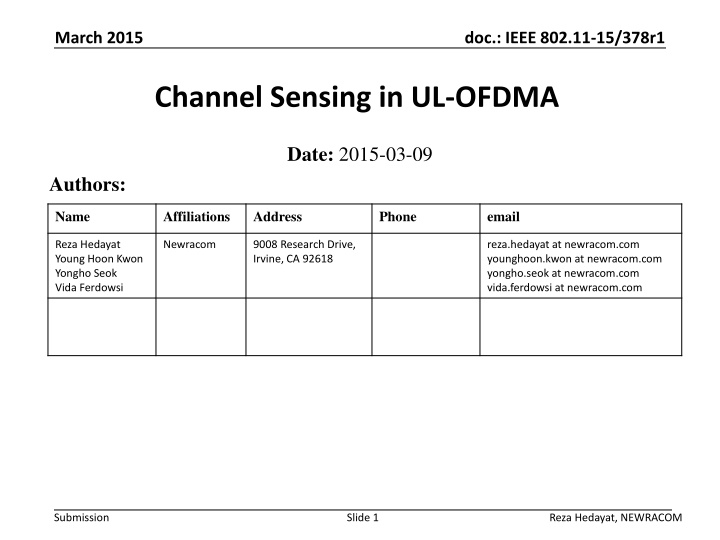
Channel Sensing in UL-OFDMA Frames for Improved Medium Utilization
Explore the challenges of channel sensing in UL-OFDMA frames within IEEE 802.11 networks, focusing on the complexity arising from multiple devices forming a single PPDU. Understand the impact of unintended clients on channel assessment and the nuances of sub-band assignments affecting sensing accuracy.
Uploaded on | 1 Views
Download Presentation

Please find below an Image/Link to download the presentation.
The content on the website is provided AS IS for your information and personal use only. It may not be sold, licensed, or shared on other websites without obtaining consent from the author. If you encounter any issues during the download, it is possible that the publisher has removed the file from their server.
You are allowed to download the files provided on this website for personal or commercial use, subject to the condition that they are used lawfully. All files are the property of their respective owners.
The content on the website is provided AS IS for your information and personal use only. It may not be sold, licensed, or shared on other websites without obtaining consent from the author.
E N D
Presentation Transcript
March 2015 doc.: IEEE 802.11-15/378r1 Channel Sensing in UL-OFDMA Date: 2015-03-09 Authors: Name Affiliations Address Phone email Reza Hedayat Young Hoon Kwon Yongho Seok Vida Ferdowsi Newracom 9008 Research Drive, Irvine, CA 92618 reza.hedayat at newracom.com younghoon.kwon at newracom.com yongho.seok at newracom.com vida.ferdowsi at newracom.com Submission Slide 1 Reza Hedayat, NEWRACOM
doc.: IEEE 802.11-15/378r1 Summary TGax SFD considers UL MU transmissions such as UL OFDMA and UL MU MIMO, which is expected to offer good medium utilization Compared to existing SU and DL MU MIMO, UL OFDMA is unique due to multiple STAs participating in forming a single PPDU This contribution focuses on channel sensing in presence of UL OFDMA frames Submission Slide 2
doc.: IEEE 802.11-15/378r1 SU vs UL MU Transmission CSMA/CA is an important aspect in 802.11 operation, where all clients sense the medium and verify if the medium is busy/idle based on which they decide to access to access the medium In SU transmission and DL MU transmission, since the frame is sent by a single node, it is straightforward how the neighboring nodes interpret the state of the medium However, multiple clients participate in forming UL OFDMA PPDUs, hence the assessment of the status of the medium becomes tricky The goal is that unintended neighboring STAs have accurate channel sensing regarding the ongoing PPDU on the entire BW Submission Slide 3
doc.: IEEE 802.11-15/378r1 Channel sensing in presence of UL OFDMA frames 802.11 offers several channel sensing mechanisms such as carrier sensing (CS), energy detect (ED), and virtual carrier sensing However despite above mechanisms, operation of UL OFDMA might get affected by unintended BSS clients, or OBSS clients that start assessing the medium in the middle of an UL OFDMA PPDU Depending on the sub-band assignment of an UL OFDMA PPDU, there could be ambiguity in channel sensing in the neighborhood of each of the clients participating in the UL OFDMA frame The problem mostly comes from the fact that 802.11 clients assess availability of the medium based on 20MHz portions, while UL OFDMA assignments could be narrower and varying across the BSS coverage Submission Slide 4
doc.: IEEE 802.11-15/378r1 Channel sensing in presence of UL OFDMA frames Channel sensing of single-transmitter transmission (SU and DL MU) All the nodes in the coverage area of the transmitter would have proper assessment of the medium status, using ED and CS mechanisms, even if they start assessing the medium in the middle of the frame Channel sensing of UL OFDMA transmission A STA that participates in forming an UL OFDMA PPDU transmits no energy on some sub-bands, hence its coverage area varies across the bandwidth. For instance, it is possible that within part of the coverage area of an UL OFDMA STA the primary channel is sensed as idle during transmission of an UL OFDMA PPDU Submission Slide 5
doc.: IEEE 802.11-15/378r1 Partially-Hidden Nodes Channel sensing in presence of UL OFDMA causes partially-hidden nodes For instance, in the case of a 40MHz UL OFDMA PPDU with two STAs (each assigned one 20MHz sub-channel) only the cross-coverage of the STAs sense the medium properly, and some of the neighborhood of each STA cannot sense that there is an ongoing frame on the whole 40MHz This is due to the fact that ED and CS mechanisms cannot detect presence of an UL- OFDMA PPDU on parts of 40MHz for the whole duration of the PPDU STA1 s Sub-band 20 MHz STA1 s Sub-band 20 MHz STA2 s Sub-band 20 MHz STA2 s Sub-band 20 MHz AP STA2 STA1 STA1 s Sub-band 20 MHz STA2 s Sub-band 20 MHz Submission Slide 6
doc.: IEEE 802.11-15/378r1 Partially-Hidden Nodes Partially-hidden nodes are not the same as hidden nodes: Hidden nodes are outside of the coverage of a frame that a STA sends Partially-hidden nodes are out of the coverage of part of the bandwidth of an UL OFDMA frame As a reference, for any frame where transmitter is a single node there is no partially-hidden node Using example of previous slide, below figures show the areas that partially-hidden nodes exist with 3 or 4 UL OFDMA nodes Next slide shows some analysis of the probability of partially-hidden nodes when an UL OFDMA PPDU is formed by N=2, 3, 4 or 5 STAs STA2 STA2 STA3 AP AP STA1 STA1 STA3 STA4 Submission Slide 7
doc.: IEEE 802.11-15/378r1 Probability of Presence of Partially-Hidden Nodes Below analysis shows that for larger number of STAs participating in an UL OFDMA PPDU the chance that unintended clients appear as partially-hidden is large and increases with number of STAs in an UP OFDMA PPDU Analysis assumptions: Transmit power =15dBm IEEE propagation loss model with exponent 2 up to 5m breakpoint, and exponent 3.5 thereafter is modeled Mean value for shadowing fading of lognormal (0dB,5dB) is used Note: each plot shows the percentage of nodes within the cross-coverage of all UL OFDMA STAs vs the union of the coverage of all the STAs Percentage of partially-hidden nodes Submission Slide 8
doc.: IEEE 802.11-15/378r1 Conclusion CSMA/CA is an important aspect of 802.11 operation that needs to be observed in presence of UL OFDMA frames UL MU transmissions require additional considerations so that unintended nodes sense presence of UL MU PPDUs across the whole bandwidth of the frame and throughout the frame duration Submission Slide 9
doc.: IEEE 802.11-15/378r1 Straw Poll Do you agree to add the following to 11ax SFD: 4.x.x TGax shall provide mechanisms that enable physical channel sensing (ED and CS) across the bandwidth and throughout the duration of an UL OFDMA frame. Submission Slide 10






